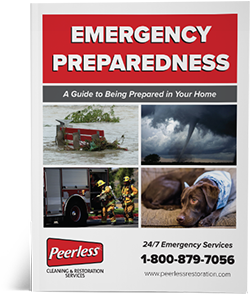Having A Plan Can Save Your Life
The weather radio buzzes to life—-another thunderstorm watch—-or maybe today it’s a tornado warning. The sky outside is turning the grey-green of pea soup and storms. As the winds pick up, the dogs start pacing in front of the front picture window and raindrops start to pelt your roof. Where do you go? What do you bring with you? Do you have a plan for when severe weather strikes?
It is that time of year again when the clouds roll in and bring those springtime thunderstorms and being prepared is an essential part of survival. When packing for a camping trip, you wouldn’t just take a blanket with you. No, you prepare beforehand and make sure you have a tent, sleeping bag, fire starting materials, food to cook over a fire, and fresh water. Believe it or not, preparing for damaging thunderstorms and preparing for the weekend camping trip are fairly similar because in either case, you may end up without any power, gas, or water.
When preparing for damaging storms it is good to make a disaster survival inventory list. Get some paper and a pencil and sit down with your family to go over the items everyone may need if something were to happen to your home. Here is a small list to get you started:
- A battery-operated flashlight and a battery-operated NOAA Weather Radio, both with extra batteries
- A list of important personal information
- Emergency contacts
- Insurance agent contact information and policy information
- Utility companies contact information
- Medical information
- A first aid kit
- Customize to fit your family’s needs
- 3 to 5 days’ supply of bottled water and nonperishable food
- Personal hygiene items (trust us, everyone will thank you)
- Blankets or sleeping bags
- Customize to fit your family’s needs
Some items you might have forgotten…
- Prescription medications
- Cash and change
- Matches or other fire starting mechanisms
- Household bleach (not the scented or color safe kind)
- 16 drops per gallon makes for safe drinking water
- Tools
- Hammer, wrench, screwdriver, and pliers
- Animals and their needs
You may even want to make a similar but smaller kit for your car. You never know where you are going to be when a disaster strikes and if you happen to be away from home you want to be ready.
When that weather radio goes off, or a notification flashes on your phone, most people do take notice. But do you really understand all the seemingly simple weather jargon?
To help with this confusion we have a small list of terms used by your local forecaster that might help you understand what is coming your way.
Flash Flood – A flood which is caused by heavy or excessive rainfall in a short period of time, generally less than 6 hours. A dam failure can also cause a flash flood, depending on the type of dam and time period during which the break occurs.
Flash Flood Watch – Flash flooding is possible in and close to the watch area, but the occurrence is neither certain or imminent. Listen to the National Weather Service, radio or television for information.
Flash Flood Warning – This means that flash flooding is in progress, imminent, or highly likely. Seek higher ground immediately or evacuate if directed to do so.
Severe Thunderstorm – A thunderstorm that produces a tornado, winds of at least 58 mph (50 knots), and/ or hail at least 3⁄4″ in diameter. Structural wind damage may imply the occurrence of a severe thunderstorm. A thunderstorm wind equal to or greater than 40 mph (35 knots) and/or hail of at least 1⁄2″ is defined as approaching severe.
Severe Thunderstorm Watch – Tells you there is a possibility of severe thunderstorms in your area likely to occur. Watch the sky and stay tuned to know when warnings are issued.
Severe Thunderstorm Warning – A severe thunderstorm is occurring or will likely occur soon in your area. Warnings are for imminent danger to life and property to those in the path of the storm. Seek shelter immediately.
Tornado Watch – Tornadoes are possible in your area. Remain alert for approaching storms. Listen to the media for updates.
Tornado Warning – A tornado has been sighted or indicated by weather radar. Take shelter immediately.
Being prepared is not just about gathering a few items and putting them down in your basement or your car. It’s also crucial do devise an escape route if you need to leave the house. Create a map of your home and develop an evacuation plan for each room in your house. These evacuation routes might change depending on the type of disaster you encounter. Once you have a plan, make sure you practice it multiple times until everyone knows what to do. If you don’t practice it, when the time comes your body will be full of adrenaline and you won’t be thinking clearly.
What if you’re not home when the disaster strikes? Make a plan for that too. Figure out travel routes from work or school. Who is going to pick up the kids, where is everyone going to meet, and how are you going to communicate if you’re not together? Sometimes it is easier to call out of town when these disasters strike. Have an out of state relative or friend serve as a point of contact and make sure everyone knows this person’s contact information. You may even want to inform your insurance agent of your plan so that they can reach you if this happens.
Stay safe, have a plan and be prepared!




